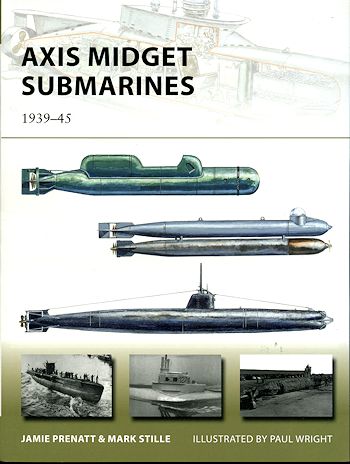 This
next title in Osprey's New Vanguard series covers midget submarines and
specifically those built and operated by Axis nations during WWII. Though there
were many Axis countries, only Italy, Germany and Japan built these boats.
Initially, many of these boats were designed for coastal defense, but their use
was quite different.
This
next title in Osprey's New Vanguard series covers midget submarines and
specifically those built and operated by Axis nations during WWII. Though there
were many Axis countries, only Italy, Germany and Japan built these boats.
Initially, many of these boats were designed for coastal defense, but their use
was quite different.
The book gives a small introduction to the subject and immediately goes
into those boats used by Italy. It was the Italians who had the greatest success
with these vessels. Most of their midget submarines were ridden by two man
crews. These are the ones which had the greatest success, sinking or damaging
ships at anchor both in Alexandria and Gibraltar. These crews basically got off
the vessels and attached explosive charges to the underside of the ships at
anchor. Of course, they had to get through various anti-submarine obstacles, and
getting away was important as well, but generally, these worked. Like many other
midgets, these were designed to be carried close to the target, either on fast
boats or submarines. As you might expect, losses were high, but many of the crew
managed to survive.
In Germany, little thought was given to the subject and when it was
decided these might be a good idea, what was developed was not all that good.
Most were little more than manned torpedoes, carrying another torpedo. Initial
midgets were not even able to dive, making their success even more tenuous.
German designers went through a considerable number of different boats, all
torpedo carrying, all equally unsuccessful. It was only at the very end of the
war that a really good midget submarine was developed and while it worked quite
well, it was a typical too little, too late.
Finally, we get to the Japanese. These are probably the most well known
boats due to their use on the Pearl Harbor attack. Like the boats of other
nations, these were relatively unsuccessful, though there were some ships
damaged or sunk during the early days of the war, including the attack on the
HMS Ramillies in the harbor of Diego Suarez on Madagascar that put the ship out
of the war for over a year.
Though considerable time and expense was spent on these craft, the
results did not justify the time or the expense. Better to have used the mother
submarines on real missions rather than haul around the midgets (larger subs
were the main transport of these vessels due to the distances needed to travel).
Many missions turned into suicide ventures with the crews being lost along with
the craft.
Yet they did play their part in the war and their story needed to be
told. In this book the authors have done a superb job of covering the
development and deployment of all the various types of Axis midget submarine
(and there ware more than you'd think). The book has a lot of superb period
photos of these craft and this is additionally enhanced by some excellent art
work. One thing I think could be improved upon is that I found quite a few of
the photos to be rather dark. You would think that with all the ability to
enhance images, that these could have been lighter and easier to see details.
Regardless, it is an excellent title and one that I'm sure you will find a
fascinating read.
July 2014
For more on the complete line of Osprey books,
visit www.ospreypublishing.com. In the US, it is
Osprey Direct at 44-02 23rd St, Suite 219, Long Island City, NY 11101., where you can
get a catalogue of available books.
If you would like your product reviewed fairly and
fairly quickly, please
contact
the editor or see other details in the
Note to
Contributors.
 This
next title in Osprey's New Vanguard series covers midget submarines and
specifically those built and operated by Axis nations during WWII. Though there
were many Axis countries, only Italy, Germany and Japan built these boats.
Initially, many of these boats were designed for coastal defense, but their use
was quite different.
This
next title in Osprey's New Vanguard series covers midget submarines and
specifically those built and operated by Axis nations during WWII. Though there
were many Axis countries, only Italy, Germany and Japan built these boats.
Initially, many of these boats were designed for coastal defense, but their use
was quite different.